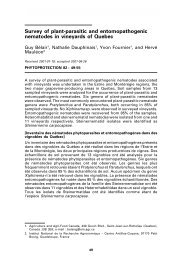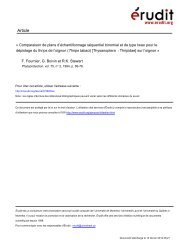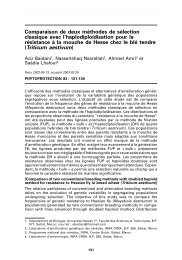Resistance to barley yellow dwarf virus, powdery mildew and leaf ...
Resistance to barley yellow dwarf virus, powdery mildew and leaf ...
Resistance to barley yellow dwarf virus, powdery mildew and leaf ...
Create successful ePaper yourself
Turn your PDF publications into a flip-book with our unique Google optimized e-Paper software.
Table 3. Ranges, means <strong>and</strong> st<strong>and</strong>ard deviations (SD) for <strong>powdery</strong> <strong>mildew</strong> (PM) scores, <strong>leaf</strong> rust (LR) scores, BYDV (ELISA)<br />
values <strong>and</strong> chromosome number (No. of plants <strong>and</strong> percent resistant plants are given in parantheses in each case; e = wheat<br />
x T. ponticum cross; i = wheat x T. intermedium cross)<br />
PM a LR a BYDV (ELISA) Chromosome number<br />
Pop. Range Mean SD Range Mean SD Range Mean SD Range Mean SD<br />
e BC2 1-4 1.84 1.28 1-4 1.21 0.70 0.008-2.000 0.283 0.385 43-73 48.40 5.71<br />
(133, 71.4%) (63, 93.6%) (190, 74.7%) (97)<br />
e BC3 1-4 2.23 * 1.39 1-4 1.92 ** 1.24 0.001-2.000 0.978 ** 0.483 42-54 45.09 ** 2.28<br />
(184, 58.7%) (148, 69.6%) (209, 8.6%) (97)<br />
i BC2 1-4 2.30 1.29 1-4 1.64 1.09 0.074-2.000 1.109 0.621 42-56 48.77 2.88<br />
(88, 58.0%) (56, 78.6%) (92, 8.7%) (43)<br />
i BC3 1-4 3.21 ** 1.00 1-4 1.93 1.22 0.110-1.964 1.026 0.515 42-50 45.25 ** 2.00<br />
(42, 21.4%) (29, 65.5%) (59 b , 11.9%) (55)<br />
a<br />
For PM <strong>and</strong> LR, 1 = resistant, 2 = moderately resistant, 3 = moderately susceptible <strong>and</strong> 4 = susceptible, (1,2) = resistant,<br />
(3,4) = susceptible.<br />
b<br />
Of the <strong>to</strong>tal 60 plants, one was not analyzed by ELISA.<br />
*,** BC3 mean signifiantly different from BC2 mean at P = 0.05 <strong>and</strong> P = 0.01, respectively, for each of the four traits (PM, LR,<br />
ELISA <strong>and</strong> chromosome number) within each of the two crosses (e, i.).<br />
Chi-square test by 2x2 contingency analysis of the<br />
three diseases showed that the patterns of resistance<br />
were significantly different for <strong>powdery</strong> <strong>mildew</strong> <strong>and</strong><br />
<strong>leaf</strong> rust in BC2 <strong>and</strong> BC3, <strong>and</strong> for BYDV <strong>and</strong> <strong>leaf</strong> rust<br />
in BC3 in wheat x T. ponticum cross (Table 6). At 10%<br />
level of confidence, chi-square for BYDV <strong>and</strong> <strong>powdery</strong><br />
<strong>mildew</strong> was significant in BC3 in the wheat x T. intermedium<br />
cross. Other chi-squares were non-significant<br />
i.e. the patterns of resistance or susceptibility<br />
were similar for any two diseases compared.<br />
From progeny of a cross between wheat x T. junceiforme<br />
Love & Love (Love), Ellneskog (2002) obtained<br />
lines resistant <strong>to</strong> <strong>powdery</strong> <strong>mildew</strong> <strong>and</strong> <strong>leaf</strong><br />
rust. Li et al. (1998) obtained wheat x A. cristatum (L.)<br />
Gaertner derivatives which were more resistant <strong>to</strong><br />
Table 4. T-test for chromosome numbers on BC2 <strong>and</strong> BC3 between resistant <strong>and</strong> susceptible plants for <strong>powdery</strong> <strong>mildew</strong> (PM),<br />
<strong>leaf</strong> rust (LR), or for BYDV<br />
both <strong>powdery</strong> <strong>mildew</strong> <strong>and</strong> BYDV compared <strong>to</strong> wheat.<br />
Such an association was not evident in the present<br />
intergeneric crosses. Larkin et al. (1995) reported that<br />
out of the disomic alien addition lines isolated from<br />
a partial amphiploid (2n = 56) of wheat x T. intermedium,<br />
one was resistant <strong>to</strong> BYDV, <strong>and</strong> one <strong>to</strong> <strong>leaf</strong>,<br />
stem <strong>and</strong> stripe rusts. In the study of Comeau et al.<br />
(1994), Agrotricum (Agropyron x Triticum) line<br />
OK211542 (2n = 56) was immune <strong>to</strong> BYDV. Through<br />
a selection for BYDV <strong>and</strong> threshable phenotype with<br />
wheat-like seed, F7-derived lines were obtained which<br />
were immune <strong>to</strong> BYDV with 44 somatic chromosomes.<br />
The low frequency of expression of immunity suggested<br />
that more than one gene was required for full<br />
expression of resistance (Comeau et al. 1994). Ander-<br />
Resistant Susceptible t-value<br />
Gene-<br />
Cross ration Number Mean Number Mean<br />
of plants chromosome of plants chromosome<br />
Disease number number<br />
PHYTOPROTECTION 85 (1) 2004<br />
Wheat BC2 LR 28 49.11 0<br />
a a<br />
x T. ponticum BC3 34 44.85 15 46.67 -2.46*<br />
BC2 BYDV 74 48.97 23 46.57 1.79 b<br />
BC3 11 46.82 86 44.87 2.76**<br />
BC2 PM 28 49.36 12 49.08 1.04<br />
BC3 27 45.44 47 45.17 0.51<br />
Wheat BC2 LR 23 47.87 7 48.71 -0.84<br />
x T. intermedium BC3 17 45.88 10 45.50 0.40<br />
BC2 BYDV 8 48.38 35 48.46 -0.42<br />
BC3 6 47.33 48 45.00 2.84**<br />
BC2 PM 21 49.24 20 47.80 1.73 b<br />
BC3 9 46.44 28 45.36 1.30<br />
*, **<br />
Significant at P = 0.05 <strong>and</strong> P = 0.01, respectively.<br />
a<br />
All plants resistant (no susceptible plants with chromosome numbers).<br />
b<br />
Significant at P = 0.10.<br />
30











